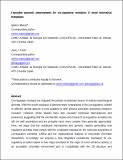Por favor, use este identificador para citar o enlazar a este item:
http://hdl.handle.net/10261/163302COMPARTIR / EXPORTAR:
 SHARE SHARE
 CORE
BASE CORE
BASE
|
|
| Visualizar otros formatos: MARC | Dublin Core | RDF | ORE | MODS | METS | DIDL | DATACITE | |

| Título: | Favorable genomic environments for cis-regulatory evolution: A novel theoretical framework |
Autor: | Maeso, Ignacio CSIC ORCID; Tena, Juan J. CSIC ORCID | Palabras clave: | Transposable elements Cis-regulation Enhancer evolution Enhancer overprinting Transcription factor binding site (TFBS) Chromatin environment |
Fecha de publicación: | 2016 | Editor: | Elsevier | Citación: | Seminars in Cell and Developmental Biology 57: 2-10 (2016) | Resumen: | Cis-regulatory changes are arguably the primary evolutionary source of animal morphological diversity. With the recent explosion of genome-wide comparisons of the cis-regulatory content in different animal species is now possible to infer general principles underlying enhancer evolution. However, these studies have also revealed numerous discrepancies and paradoxes, suggesting that the mechanistic causes and modes of cis-regulatory evolution are still not well understood and are probably much more complex than generally appreciated. Here, we argue that the mutational mechanisms and genomic regions generating new regulatory activities must comply with the constraints imposed by the molecular properties of cis-regulatory elements (CREs) and the organizational features of long-range chromatin interactions. Accordingly, we propose a new integrative evolutionary framework for cis-regulatory evolution based on two major premises for the origin of novel enhancer activity: (i) an accessible chromatin environment and (ii) compatibility with the 3D structure and interactions of pre-existing CREs. Mechanisms and DNA sequences not fulfilling these premises, will be less likely to have a measurable impact on gene expression and as such, will have a minor contribution to the evolution of gene regulation. Finally, we discuss current comparative cis-regulatory data under the light of this new evolutionary model, and propose that the two most prominent mechanisms for the evolution of cis-regulatory changes are the overprinting of ancestral CREs and the exaptation of transposable elements. | Versión del editor: | https://doi.org/10.1016/j.semcdb.2015.12.003 | URI: | http://hdl.handle.net/10261/163302 | DOI: | 10.1016/j.semcdb.2015.12.003 | Identificadores: | doi: 10.1016/j.semcdb.2015.12.003 e-issn: 1096-3634 issn: 1084-9521 |
| Aparece en las colecciones: | (CABD) Artículos |
Ficheros en este ítem:
| Fichero | Descripción | Tamaño | Formato | |
|---|---|---|---|---|
| favorableframework.pdf | 642,94 kB | Adobe PDF |  Visualizar/Abrir |
CORE Recommender
PubMed Central
Citations
9
checked on 13-abr-2024
SCOPUSTM
Citations
14
checked on 15-abr-2024
WEB OF SCIENCETM
Citations
12
checked on 24-feb-2024
Page view(s)
276
checked on 19-abr-2024
Download(s)
480
checked on 19-abr-2024

